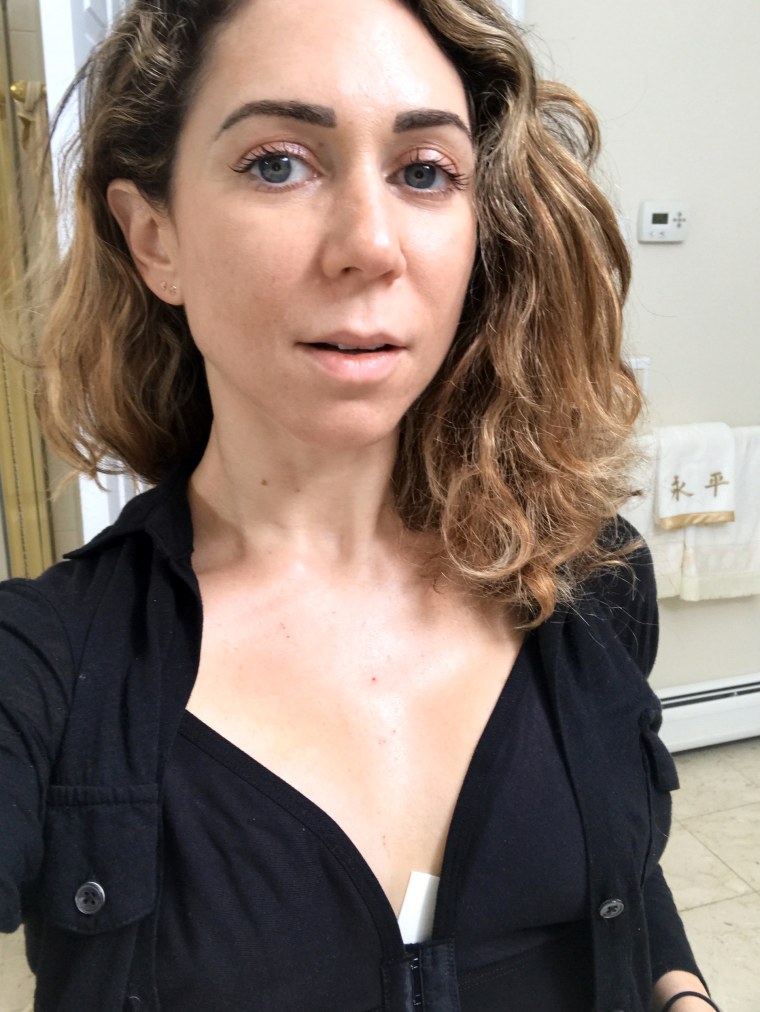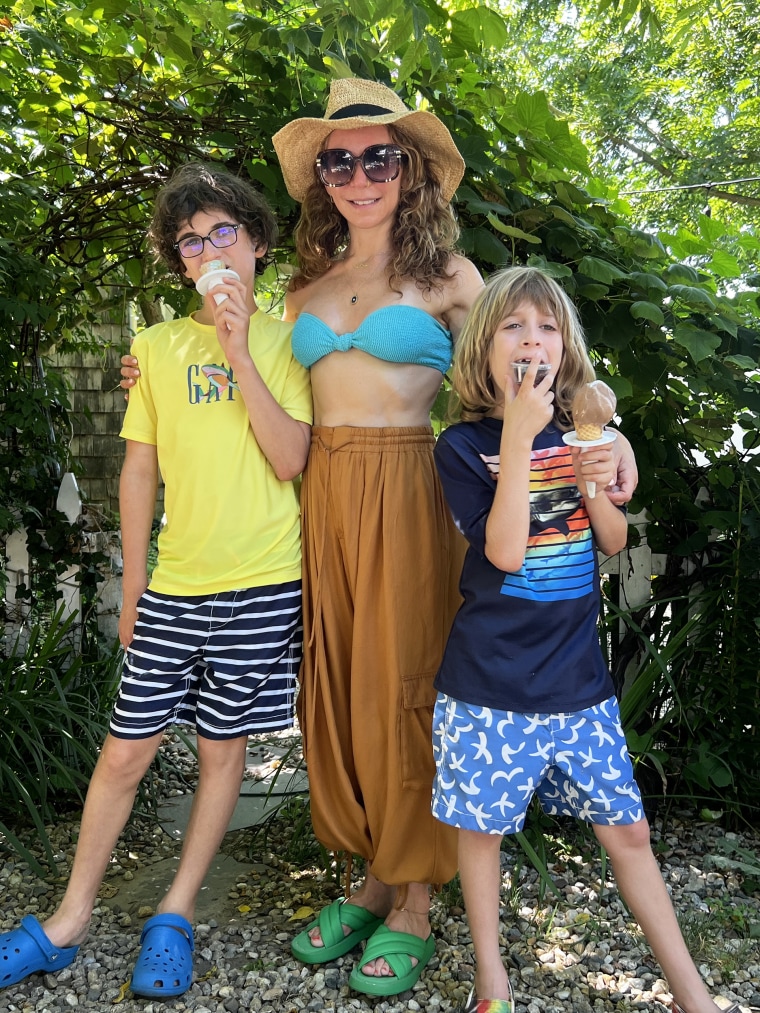It wasn’t a matter of if I would ever get a boob job, it was more like when. Many women in my life have had at least one breast augmentation, which for me, very much normalized the procedure. I come from a long line of women who believe that if you don’t like how something about you looks, you should “fix” it. After breastfeeding two kids for a combined total of 30 months, and you know, living in a human body for nearly 40 years; my breasts had become unrecognizable to me. Meanwhile, during my nightly sweep of the Instagram posts I had missed during the day, I consumed filtered photo after filtered photo of perfect-looking influencers and celebrities at least 15 years my junior (almost none of them were moms). This was in 2016, before the social media landscape embraced “authenticity” as a rule. None of the folks in the squares on my screen advertised that they’d undergone the knife, nor were they forthcoming about any Photoshopping that had gone into their posts. But I wasn’t ignorant. I knew that a lot of what I was looking at was not real, and yet I fell under their spell all the same. It was pretty depressing, looking at these beautiful women and then seeing myself in a bra or swimsuit with what amounted to two empty sacks of skin. My breasts had become something that I strongly felt needed fixing.
On a warm October day in 2017, I kissed my young children and husband goodbye, and called myself an Uber. I wasn’t nervous — I was excited. At the time, it had not seemed like a big enough deal for me to have asked anyone to accompany me to the doctor’s office. By the time of my surgery, I’d been in and out of the office enough times that I was on a first-name basis with the staff. “How’s your mom?” the receptionist would always ask me, within minutes of my arriving. I kind of felt at home there.
I went into the exam room. It was the same room where I’d stuffed an array of implants of varying sizes into my bra just months before. I remember that on the day that I’d gone “implant shopping,” I’d worn a red-and-white striped top and a corduroy miniskirt. I remember looking at myself in profile in the mirror that spanned an entire wall and thinking, “Yes. This is amazing. Imagine walking through life with boobs like these.”
When I was alone in the room, I took a selfie with my pink hospital gown on. The pre-surgery photo seemed like a thing that people did on all the YouTube videos I’d watched — though I had no plan at the time to post about the procedure on Instagram. I’d mostly kept my decision to get a boob job private.
After I awoke from the surgery, my doctor’s expression told me that there had been some kind of hiccup. He sat in a swivel stool beside me, and took a deep breath.
After I awoke from the surgery, my doctor’s expression told me that there had been some kind of hiccup. He sat in a swivel stool beside me, and took a deep breath.
“I didn’t want to have to do this,” he said. (Truly the last thing you want to hear about one’s surgery.) “But your body fought me pretty hard.”
He explained that there had been a vessel on the right side of my chest that had bled more than they expected. They’d been able to get most of the fluid out and stop the bleeding, but they’d inserted drains on either side of my torso to collect any excess fluids. I was not thrilled, but was happy that the whole thing was over and I could start my journey to recovery at my parent’s house — safely away from my toddler who slept with us and who could kick me in my surgery site in the middle of the night.
At some point in the early afternoon, I woke up with a heavy pressure on the right side of my chest. It felt a little like when my milk was coming in for the first time — a foreign fullness that wasn’t painful but just . . . strange.
“Is this supposed to happen?” I asked my mom.
“Sure,” she said. “It’s normal to have swelling.”
But as the day wore on, the pressure on my right breast got heavier and heavier. It couldn’t have been normal to only have one breast swollen, right? I convinced myself that I could chalk up the feeling to the fact that bodies are weird, and you never know just how they’re going to react after being rifled around in. I watched an HGTV home renovation series and unsuccessfully tried to distract myself from the mounting pain.
When I looked down at my body, I saw that yellowish green splotches had begun to bloom across my right breast and it was hot to the touch. And, while the left breast resembled what my breastfeeding boobs looked like when I was super engorged, my right breast was shaped funny — like a rectangle, kind of. My mom looked worried when I showed her, but she said it was probably OK. My father, a surgeon, was still with patients when I called for his advice. For some stupid reason, I didn’t want to call my own surgeon for fear of bothering him.
It felt like whatever was inside me was trying to claw its way out through my throat, like it had a life and an agenda of its own.
By the time my father came home from work, my right breast looked like an ice pack had implanted itself inside my chest cavity. I was crying from the pain. It felt like whatever was inside me was trying to claw its way out through my throat, like it had a life and an agenda of its own. My father took one look and told me to call my doctor immediately and send him photos. Two seconds after I sent the photos, my doctor called me back. He’d been in the middle of his daughter’s piano recital, and was doing his best whisper-voice but his tone was urgent. So was his directive: “How fast can you get to the city? I’ll meet you at my office.”
I don’t remember the car ride with my dad from New Jersey to my doctor’s office on the Upper East Side of New York City, or much of what happened after my doctor confirmed what my dad had said about this being a hematoma. I remember rushing to the hospital and feeling scared out of my mind, quietly wondering to myself if it was possible to die from a boob job. I couldn’t imagine that when I’d kissed my kids and my husband goodbye that morning, that it might be the last time they’d ever see me. I’d never considered the possibility that there could be life-threatening downsides to this surgery. I had never thought to Google “risks of breast augmentation” before that day. Perhaps somewhere deep inside, I didn’t want to know.

When we got to the hospital, the pain was off the charts — worse than either of my cesarean sections, worse than my appendix nearly bursting in college. When I was about to pass out, they gave me morphine. Everything in my body was screaming, “Get this thing out of me.” If I could have, I would have dug it out myself. When I was finally wheeled toward the doors of the operating room, I imagined what a relief it would be to be under anesthesia. That night, I had my second breast surgery in just over 12 hours.
Postoperative hematomas are one of the most frequent complications in aesthetic surgery, research shows. A hematoma can occur when blood pools in pockets under the skin around the incision site, which is exactly what had happened to me. It took me weeks to recover from that emergency surgery (including an infection at the drainage sites) during which time I could not be fully present as a parent, as I moved through the pain and maintenance of being post-op. After a breast revision surgery months later, I finally had the cleavage that I’d dreamed of. But, if I could do it all over again, well, I wouldn’t.
The algorithm knows me well, and every day, serves me a curated and steady stream of makeup tutorials for women over 40, momfluencers talking about messy motherhood, anything related to Hailey Bieber, and of course, the young influencers with impossible boob-to-hip ratios (old habits die hard). Lately, though, I’ve noticed my influencers getting younger and younger. There’s more content than ever aimed at folks barely old enough to vote, about “tweakments,” preventative Botox and anti-aging skin care. Just last month, a 14-year-old girl’s TikTok went viral, where she detailed the 4,324-step (joking but not really) beauty routine she uses to “slow down the process of aging.” It’s not an anomaly, but a reflection of the anti-aging rhetoric being marketed to teens. Experts say that young people account for a growing slice of the plastic surgery market, and that patients seeking nonsurgical treatments — like fillers — are trending younger, too, according to NBC News.

I have a 9-year-old child, who is nonbinary, and an 11-year-old son. My kids do not have their own phones yet, nor do they look at or engage with social media, but I know the time will come. I know that this means they will also be exposed to the same unattainable, heteronormative, ableist, white beauty ideals that dominate my own feeds. I recently took my 9-year-old to see “Barbie,” which they summarized as “a movie mostly about Barbie not having a vagina.” (They weren’t entirely wrong.) The hierarchy of “beauty” presented in the film is uncomfortably accurate — the tiny, blonde, perky-boobed Barbie as the “default,” while the Barbies who are pregnant, curvy, Black, brown or in wheelchairs play second (and third and fourth and so on) fiddle.
I’ll never forget the time that same child, maybe 3 or 4 at the time, looked in the mirror and tugged at their skin in tears.
“Why don’t I look like that?” they said, pointing to the “Barbie: Fairytopia” movie playing in the living room. They didn’t understand why they didn’t have breasts or an hourglass figure like the fictional women on the screen. I’m not singularly blaming Barbie here for my boob job, or for causing an existential crisis in my child. But there is no arguing the ways that a culture dominated by media (from magazine covers to movies to cartoons) steeped in capitalism, queer-phobia and white supremacy shapes how we think about ourselves.
Over the next few years, the faces and bodies that will be marketed to my children will likely be bodies that are either filtered, Facetuned, injected or surgically altered. The normalization and transparency around cosmetic surgery and noninvasive aesthetic procedures for Generation Z appears to be exponentially higher than when I was in my formative years.
As someone who has experienced both the heavy influence of the online world, and the life-threatening risks of plastic surgery, Gen Z’s nonchalant approach to cosmetic body augmentation (not including gender-affirming procedures and surgeries) terrifies me. I wonder what my children will feel compelled to do to fit in, or what they will expect when they look at themselves and at the bodies of their peers. I wonder if there’s room for this generation, or any generation, to ever feel comfortable in their own skin. I know that I am still on that journey of self-acceptance at 43 years old. Will we ever be enough just the way we are or will there always be something about us that needs “fixing”? For my children’s sake, and for my own, I hope that day becomes a reality.